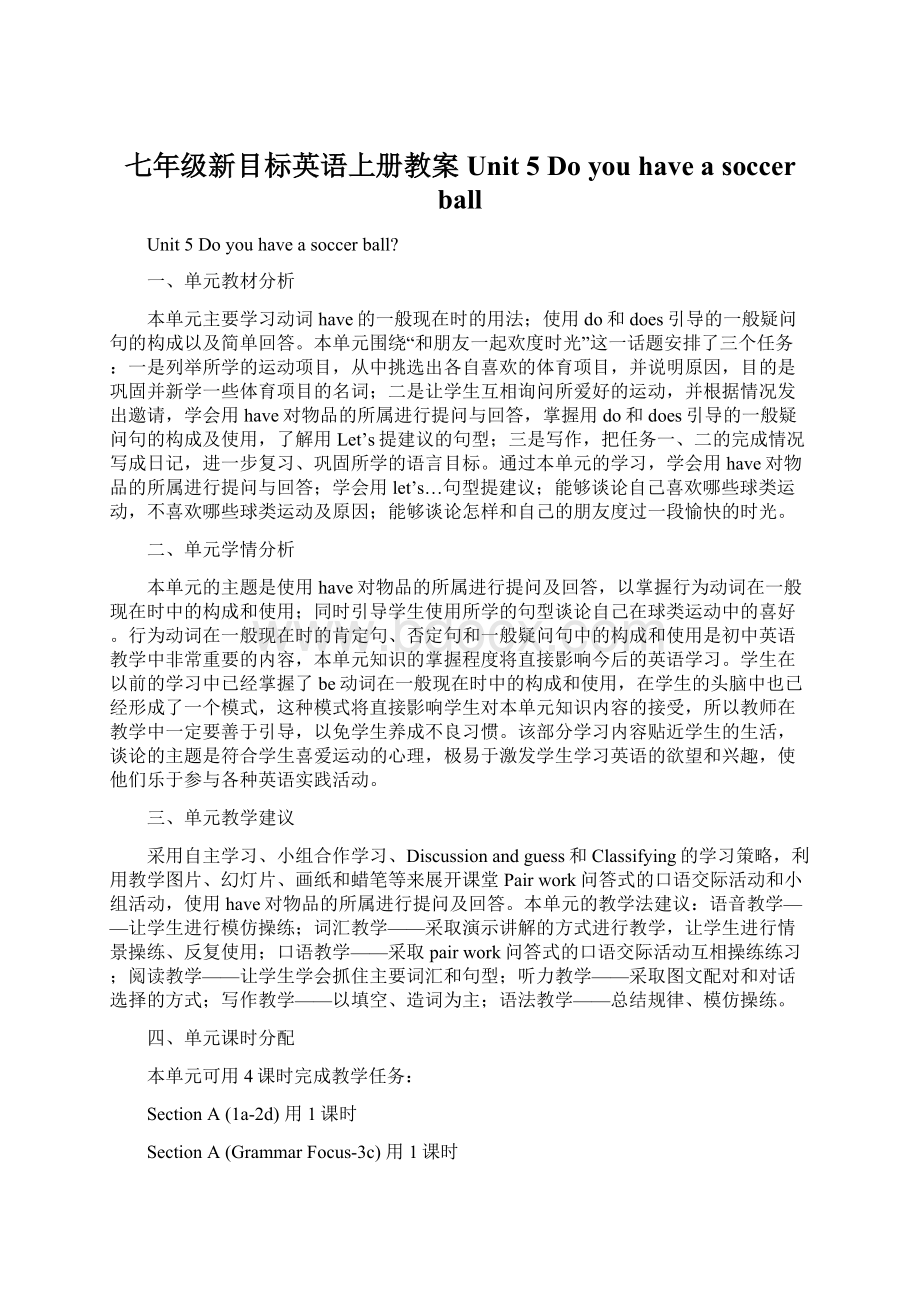七年级新目标英语上册教案Unit 5 Do you have a soccer ballWord文档格式.docx
《七年级新目标英语上册教案Unit 5 Do you have a soccer ballWord文档格式.docx》由会员分享,可在线阅读,更多相关《七年级新目标英语上册教案Unit 5 Do you have a soccer ballWord文档格式.docx(19页珍藏版)》请在冰豆网上搜索。

同时引导学生使用所学的句型谈论自己在球类运动中的喜好。
行为动词在一般现在时的肯定句、否定句和一般疑问句中的构成和使用是初中英语教学中非常重要的内容,本单元知识的掌握程度将直接影响今后的英语学习。
学生在以前的学习中已经掌握了be动词在一般现在时中的构成和使用,在学生的头脑中也已经形成了一个模式,这种模式将直接影响学生对本单元知识内容的接受,所以教师在教学中一定要善于引导,以免学生养成不良习惯。
该部分学习内容贴近学生的生活,谈论的主题是符合学生喜爱运动的心理,极易于激发学生学习英语的欲望和兴趣,使他们乐于参与各种英语实践活动。
三、单元教学建议
采用自主学习、小组合作学习、Discussionandguess和Classifying的学习策略,利用教学图片、幻灯片、画纸和蜡笔等来展开课堂Pairwork问答式的口语交际活动和小组活动,使用have对物品的所属进行提问及回答。
本单元的教学法建议:
语音教学——让学生进行模仿操练;
词汇教学——采取演示讲解的方式进行教学,让学生进行情景操练、反复使用;
口语教学——采取pairwork问答式的口语交际活动互相操练练习;
阅读教学——让学生学会抓住主要词汇和句型;
听力教学——采取图文配对和对话选择的方式;
写作教学——以填空、造词为主;
语法教学——总结规律、模仿操练。
四、单元课时分配
本单元可用4课时完成教学任务:
SectionA(1a-2d)用1课时
SectionA(GrammarFocus-3c)用1课时
SectionB(1a-2c)用1课时
SectionB(3a-SelfCheck)用1课时
SectionA1(1a-2d)
一、教学目标:
1.语言知识目标:
1)能掌握下列词汇:
do(does),have,tennis,ball,ping-pong,bat,soccer,soccerball,basketball,let,us,let'
sgo,we,late,has,get
2)学会用have对物品的所属进行提问以及应答,学会使用do和does引导的一般疑问句:
①—Doyouhaveabaseball?
—Yes,Ido./No,Idon'
t.
②—Doesshe/hehaveatennisball?
—Yes,she/hedoes./No,she/hedoesn'
t.
③—Dotheyhaveasoccerball?
—Yes,theydo./No,theydon'
3)学会用Let’s…提建议。
2.情感态度价值观目标:
利用学生喜爱运动的心理,激发学生学习英语的欲望和兴趣,使他们乐于参与各种英语实践活动。
在小组活动中,培养学生团结协作精神。
二、教学重难点
1.教学重点:
1)通过运用have对物品的所属进行提问以及应答,来掌握一些运动项目的词汇。
2)在询问对方是否有某物的对话中学会使用do和does引导的一般疑问句。
3)学会用祈使句来向对方提出建议。
2.教学难点:
学会使用第三人称单数的一般疑问句Does…?
及回答做对话。
三、教学过程
Ⅰ.Presentation
1.Presentthekeyvocabulary.
(Showabasketballtotheclass.)
T:
What’sthisinEnglish?
S1:
It’sabasketball.
Yes,youareright.Readafterme.B-A-S-K-E-T-A-B-L-L,basketball.
Ss:
B-A-S-K-E-T-A-B-L-L,basketball.
(Showthestudentsotherobjects.Teachthenewwords“soccerball,ping-pongball,volleyball,tennisbat,ping-pongbat”inthesameway.)
Readthewordstogethertwice.
…
2.Lookatthewordsin1aandmatchthewordswiththethingsinthepicture.
Number1is(a),tennisball.What’sNumber2Matchthem.
Askonestudenttoshowtheanswersandcheckthem.
3.Presentthekeystructure.
Presentthesequestionsandanswers.
(Pointtoastudentwhohasapencilbox.)
Doyouhaveapencilbox?
Yes,Ido.(Nodyourheadyes)
(AskS2)Doesshehaveapencilbox?
S2:
(HelpS2answer)Yes,shedoes.
Doyouhaveabasketball?
No,Idon’t.(Shakeyourheadno)
(AskS2)Doesshehaveabasketball?
(HelpS2answer)No,shedoesn'
Practicethedrill“Doyouhavea…?
”,"
Doeshe/shehavea…?
"
inpairs.Youcan
useyourschoolthingsandtheseballs.Lookatthemodel,thenpracticelikethis.
Model:
Yes,Ido.
S3:
Doseshehaveabasketball?
S4:
Yes,shedoes.
Doyouhaveasoccerball?
No,Idon’t.
Doseshehaveasoccerball?
No,shedoesn'
(Studentsworkinpairs.)
II.Listening
Lookatthefouritemsof1binthepictures.Listentotheconversation.
(Playtherecordingof1bthefirsttime.Studentsonlylisten.)
Listentotheconversationandcirclethewordsyouhear.
(Playtherecordingagain.)
Checktheiranswers.
…S2…
III.Pairwork
1.Readtheconversationsin1c.(Askstudentstorepeat.)
2.Lookatthepicturein1aandpracticetheconversationwitheachotherinpairs.
Doyouhave…?
Yes,Ido.
Doyouhavea…?
No,Idon’t.
3.Workingroupsoffourandusethepicturetopracticethesimilarconversationswiththenewwords.(basketball,baseballbat,soccerball,volleyball,computer,ping-pongbat,baseball)
Askandanswerthequestionsasmanyasyoucan.
Doyouhavea…?
…
IV.Listening
1.T:
Lookatthepicturesin2bandnamethem.Whatarethese?
(Pointatthebaseball,basketball,soccerball,volleyball.)
Theyare…
Therearefourchildrenintheconversations.Whoarethey?
Pleaselistenandfindtheanswer.
(Playtherecorderforthefirsttime.)
S:
I’llplaytherecorderforthesecondtime.Listenandnumberthepictures(1-4).
(Studentslistenforthesecondtime.)
Listentotheconversationin2b.Matchthepeoplewiththeballs.
(Studentslistenandmatch.Teachercheckstheiranswer.)
2.Listentotheconversationsagainandfillintheblanks.
Conversation1
Bob:
Doyouhavea___________,Paul?
Paul:
DoesyourbrotherAlanhaveone?
_____________
Conversation2
John:
Hi,Mike.
Mike:
Hi,John.
Iwant